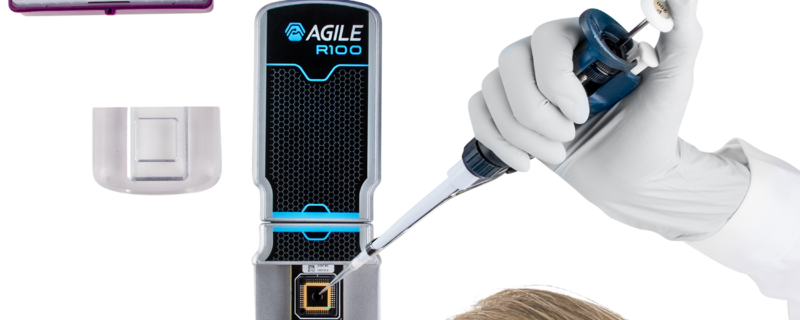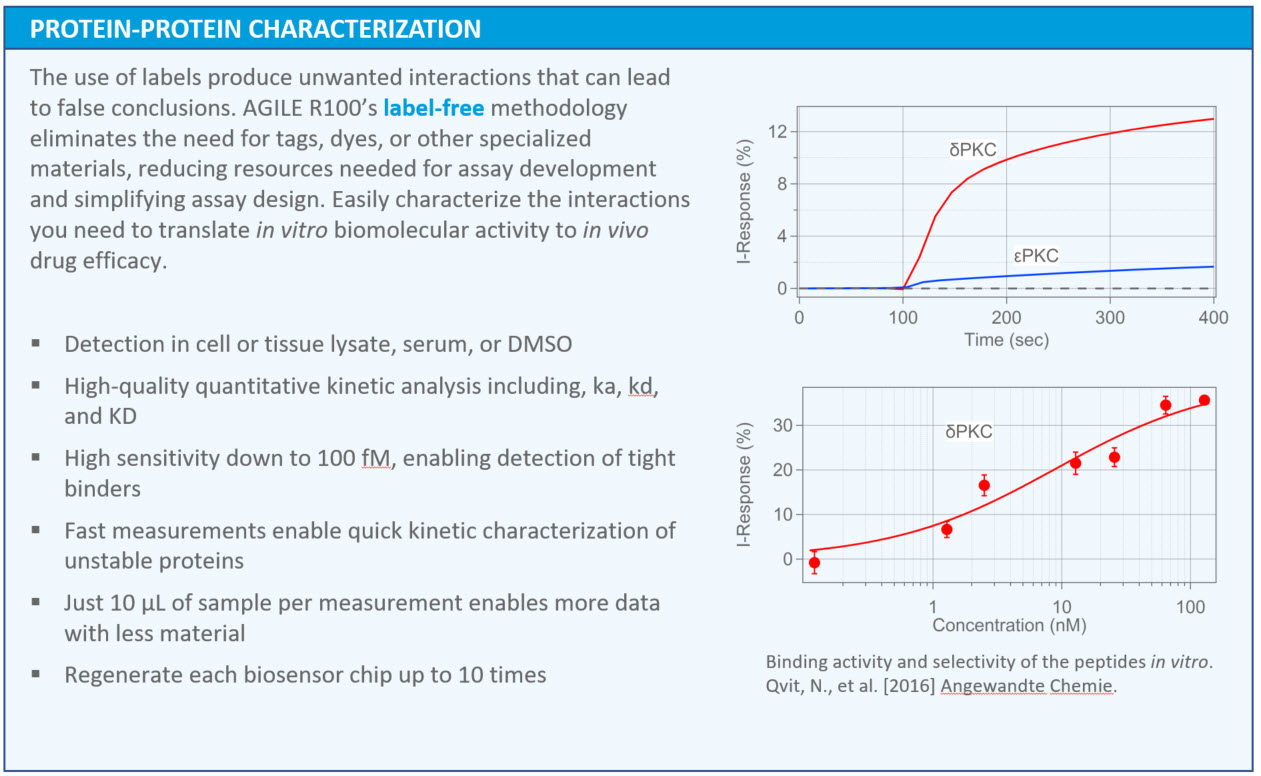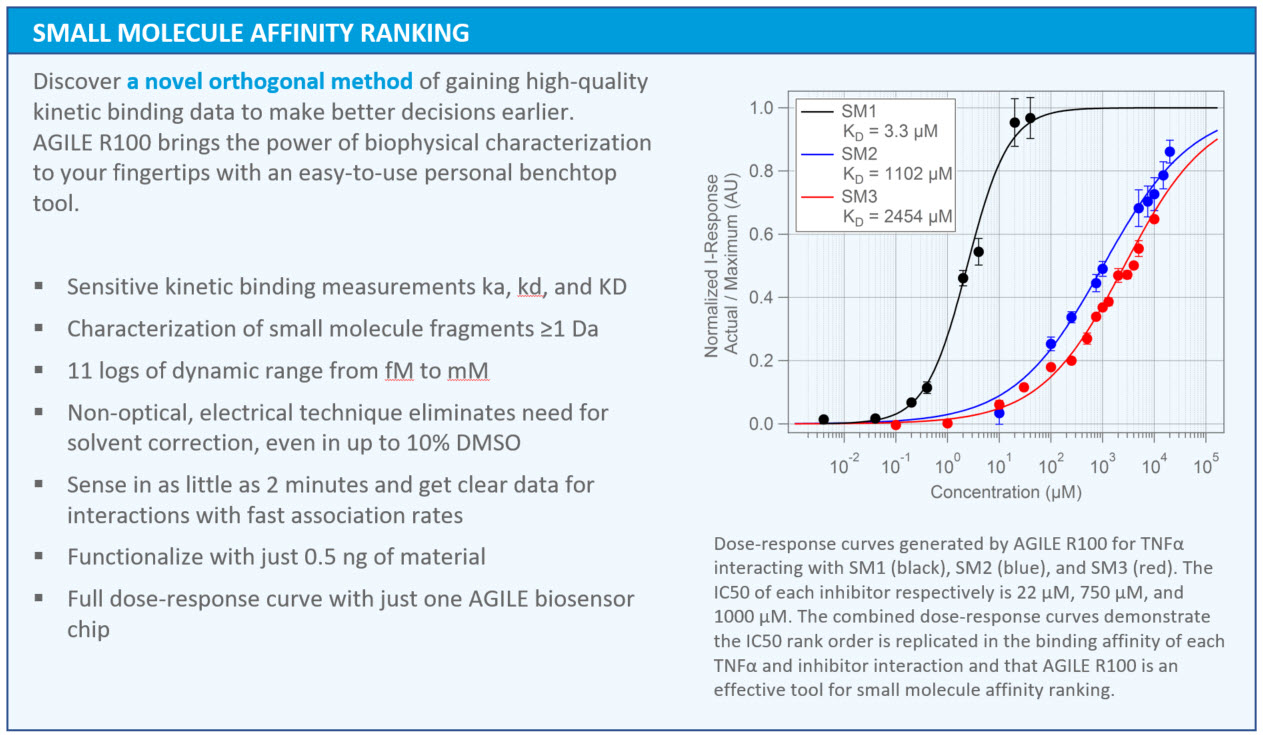
Label-free kinetic characterization in the palm of your hand
Kinetic binding and characterization of biotherapeutic candidates is an important part of screening and selection during drug discovery. The ease and speed with which this information is obtained directly affects decisions about whether a candidate is suitable for further research. Thus there are important considerations to be made when choosing a method for analyzing biophysical data.
Nanomedical Diagnostics has created an innovative solution to provide real-time kinetic characterization with a device that is barely larger than a cell phone. AGILE R100 is a benchtop label-free assay built with proprietary Field Effect Biosensing (FEB) technology that enables detection even with small amounts of starting material, low concentrations, and weak biomolecular interactions.
How it Works
AGILE R100 uses a graphene biosensor chip built with proprietary Field Effect Biosensing (FEB) technology. FEB is an electrical technique that measures the current across a field effect graphene biosensor to which targets are immobilized (Figure 1). Any interaction or binding that occurs on the surface causes a change in conductance that is monitored in real-time (Figure 2), enabling accurate kinetic, affinity, and concentration measurements.

“A baseline read is taken with AGILE R100 prior to immobilizing the target. As the target is immobilized to the surface of the AGILE biosensor chip, the change can be seen in the built-in software’s sensorgram. As free-in-solution analyte is introduced, the association between target and analyte can be viewed in the real-time sensorgram as binding occurs. When dissociation occurs, the response decreases, which is also shown in the sensorgram.” See the video below to see how the AGILE R100 is used.
Biophysical Testing – Key Considerations
Label-free
Label-free assays, like AGILE R100, are becoming more popular as they eliminate the possible unintended interference of the label and they remove the additional steps needed to attach the label.
Sample Prep
In evaluating testing methods it is important to consider whether the sample needs to be purified prior to evaluation and also the sample volume required. Crude sample testing without purification saves time and resources.
AGILE R100 enables detection in crude samples using minimal volume (10 uL). For example, it can measure protein-protein binding kinetics directly in complex media such as plasma and cell culture supernatant. There is no need to coat the graphene sensor surface with excess protein because only a few thousand proteins are needed on each sensor for functionality. This enables functionalization using nM concentrations, with low volumes of material.
In-house vs. outsourcing
Depending on the analysis method used and subsequent equipment and labor costs, some companies may decide to outsource. For example, surface plasmon resonance (SPR) and Bio-Layer Interferometry (BLI) platforms for kinetic analysis are more expensive, and as a result, companies may choose to outsource their biophysical testing when using these methods. Outsourced testing adds time and cost when compared with more affordable in-house methods. AGILE R100 is simple to use and enables cost-effective real-time kinetic binding data in less than a day.
High Sensitivity
While optical methods can have difficulty analyzing small molecules, samples with high concentrations of analyte, samples with DMSO, and small sample sizes, AGILE R100 uses a sensitive electrical technique, which permits a wide range of measurement from small molecules down to 1 Dalton up to larger molecules. High concentrations and DMSO do not interfere with AGILE R100 because the technology is not based on optics.
High Throughput
With an increasing number of candidates being screened in drug discovery, testing methods should be high-throughput during hit identification as to not create a bottleneck in the process. The AGILE R100 can take a measurement every 15 minutes. AGILE R100 was designed to be an assay development tool that can take manual measurements quickly and cost-effectively. It is a precursor platform to the AGILE R200 (www.nanomedicaldiagnostics.com/pipeline) currently in development. The workflow would include assay development on the AGILE R100, then hit identification on the AGILE R200. Since the same platform would be used to develop the assay as well as ID hits, researchers can avoid data/procedure translations from one technology platform to another.
AGILE R200 is a high-throughput system that will be the only platform capable of providing biophysical data (like SPR) in a completely automated fashion. AGILE biosensor chips are built into 96-well plates that can be used with standard automated liquid handlers Like AGILE R100, it will be able to take a measurement every 15 minutes, providing 384 measurements an hour, or over 3,000 measurements in an 8-hour workday. Since it can integrate with automated robotics, it could be run 24 hours, providing 9,000 measurements in a day, easily surpassing the throughput of any kinetic binding tool today, with much less material used.
Reproducibility/Reliability
AGILE R100 is mass-manufactured in partnership with a MEMS foundry to produce biosensors with high consistency, quality, and reliability. Strict inspection requirements and stringent specifications at every step of the fabrication process ensures only the highest-quality biosensors pass manufacturing to be delivered to researchers, enabling accurate, sensitive, reproducible measurements.
Additional benefits of the AGILE R100 include:
- Microfluidic-free design means no clogging or dead volume.
- Simple open-pipetting platform enables on-the-fly assay modification.
- Reusable biosensor chips can be regenerated up to 10 times a chip.
- Easy-to-learn tool requires little to no training.
- Automated real-time analysis software enables instantaneous readouts of kinetic data.
- A full dose-response curve within hours, with just one biosensor chip
Applications for AGILE R100:
- Small molecule or fragment hit validation and lead optimization
- Antibody characterization and development
- Biomolecular analysis of aptamers, peptides, proteins
Specific application area examples:
Figure 3:

Figure 4:

For more information on AGILE R100, please www.nanomedicaldiagnostics.com/agile-r100